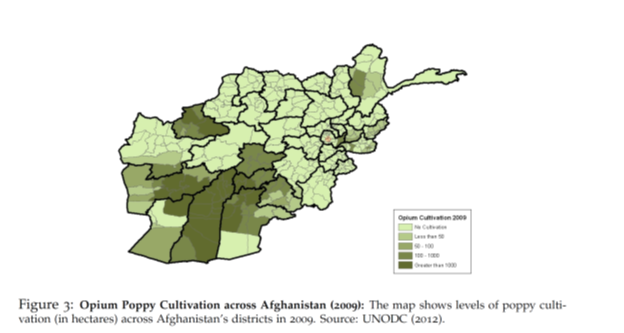
An underrated mistake in US policy in Afghanistan was its long-running effort to suppress the cultivation of opium poppy and, in turn, the production of heroin and other opiates.
A thread. 1/19
A thread. 1/19
The US effort to suppress opium production in Afghanistan is an issue in which I’ve long taken an interest. It was the topic of my undergraduate thesis, which was later published in the Journal of Law and Economics. It also generated a follow-on project. 2/19
My first paper on the US effort to discourage Afghan farmers from cultivating opium poppy focused on the most basic question: can it work? The answer was a likely “no” for reasons that relate to the basics of supply and demand. 3/19
Policies to discourage poppy cultivation (promoting other crops or eradicating the poppy crop) involve efforts to shift the supply curve. But basic data on input costs, crop yields, and eradication efforts reveal that the plausible shifts in the supply curve were modest. 4/19
The impact of a shift in the supply curve on the quantity produced depends on the slope of the demand curve. Here, data indicate that the elasticity of demand (specifically, from traffickers for the opium they collect from farmers) will be quite low. 5/19
Why would the elasticity of demand from traffickers be low? Two reasons: First, retail demand elasticities are modest. But second, and more importantly, the price at Afghan farms turns out to account for a very modest share of traffickers’ total costs. 6/19
The cost of getting opiates to retail markets largely involve the risks of trafficking itself. Consequently, demand for opium from Afghan farmers, which is a crucial input in the chain, is highly inelastic: Large changes in price have modest effects on the quantity demanded. 7/19
Together, these basic economic factors imply that the effect of efforts to suppress poppy cultivation would be primarily to increase prices paid to farmers rather than reduce production. And indeed, this has been borne out over the long haul. 8/19
As documented in a recent report by the UN’s Office on Drugs and Crime, Afghan poppy cultivation has if anything drifted gradually upward since the US first ramped up its expenditures on the effort to suppress opium production (roughly in 2005): unodc.org/documents/crop…
9/19
9/19

For my full paper on this first set of issues (published in the Journal of Law and Economics), see the link below: journals.uchicago.edu/doi/10.1086/58…
10/19
10/19
Unfortunately, it gets worse. Not only did total opium production fail to decline, but it shifted (predictably) towards the regions of the country the government was struggling to control. 11/19
The effort to suppress opium production was premised in part on the idea that the drug trade was funding the insurgency. While there’s a sense in which this is true, the suppression policy quite severely aggravated the problem. 12/19
As shown in the figure below, US expenditure on efforts to suppress poppy cultivation escalated substantially during the mid-2000s. This was met with a shift in poppy cultivation towards areas in which the Taliban has long exerted its greatest influence.
13/19
13/19

The shift in poppy cultivation can most effectively be seen using maps: BEFORE the increase in anti-opium expenditures, poppy cultivation was quite prevalent in districts around the country. Afterwards, however, cultivation consolidated in Taliban-intensive areas.
14/19

14/19


So the US set out to reduce the Taliban’s ability to profit from the drug trade. But in effect, the US eliminated competition from government-friendly regions of the country, which INCREASED the Taliban’s ability to profit from the drug trade. A disaster. 15/19
I published some of these main ideas as a paper in the 2013 AEA Papers & Proceedings: aeaweb.org/articles?id=10…
Some of the figures from earlier in the thread can be found in an expanded working paper, which is available here: papers.ssrn.com/sol3/papers.cf…
16/19
Some of the figures from earlier in the thread can be found in an expanded working paper, which is available here: papers.ssrn.com/sol3/papers.cf…
16/19
The outcome observed in Afghanistan can be generalized to many contexts in which a government lacks the capacity to follow through on policies of prohibition. The most successful suppliers of prohibited goods and services will tend to be “the bad guys.” (like Al Capone)
17/19
17/19
Long-run outcomes as they relate to the production of opium in Afghanistan are depressing in part because they were predictable. At the same time, this is a useful case study in the power of basic economics to shed light on difficult problems. 18/19
It is deeply disappointing, however, that such an ineffective and outright counterproductive policy towards Afghan opium production was sustained for such an extended period of time. 19/19
• • •
Missing some Tweet in this thread? You can try to
force a refresh



